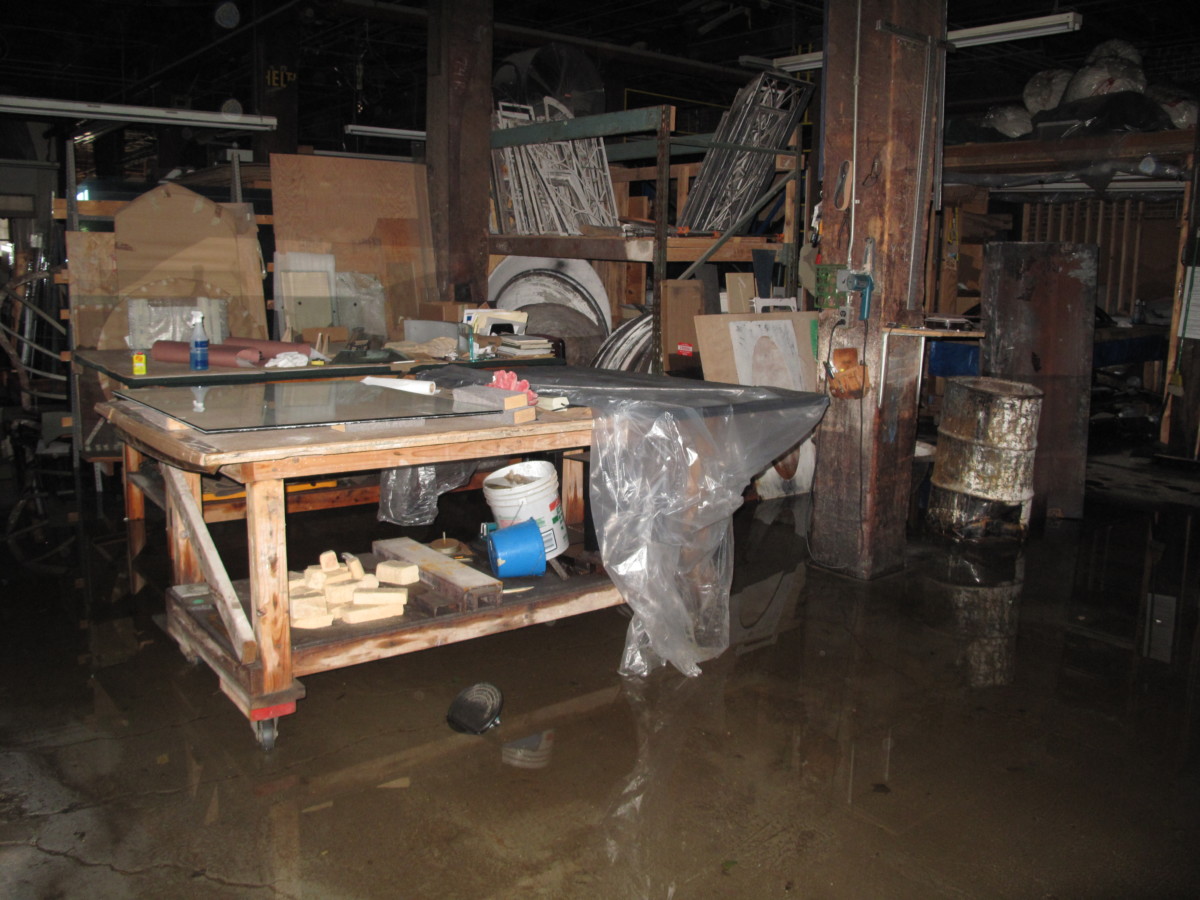Before leaving The Liberty Warehouse on evening of October 28, 2012, Jeffrey Torem, the director of catering, had the perimeter lined with an estimated 2,500 sandbags. The waterfront event space at the end of Brooklyn’s Pier 41 had hosted a bat mitzvah that Sunday afternoon. Now, they were hunkering down for the arrival of Hurricane Sandy.
Five days later, when Torem was able to get back into the building, 5 feet of water had come and gone, leaving a grim scene in its wake. “I saw complete chaos,” Torem says. “Everything you could possibly think of that came out of that river was in this building.”
Broken doors. Dirt. Garbage. Bent tables, broken chairs, linens, kitchen equipment, human waste, broken mirrors, glassware, silverware, and tires. All of it strewn about the ground floor of the 15,000-square-foot venue. A now-mangled metal garage door had been completely pushed in. Tables had been uprooted from the floor by the water, and crashed into and damaged the red-brick walls. All of the windows on the south side of the building were destroyed. Flashlights provided the only light in the powerless building. The built-in bar that once stood on the ground floor was found two blocks away on Coffey Street. The floodwaters had carried it nearly a quarter of a mile inland.
But surprisingly—or unsurprisingly if you’ve ever met Torem—less than a month later on the first of December, the venue’s staff reopened their doors for a wedding, and received a standing ovation.

The devastation from Sandy was widespread. Homes and businesses, many of which did not have adequate infrastructure or insurance coverage, flooded up to 11 feet. The neighboring Red Hook businesses that also occupied ground-floor spaces at 175 Van Dyke Street sustained damage similar to that of The Liberty Warehouse, but none recovered as quickly, or heroically. ABC7 Eyewitness News reported in 2013 that the Red Hook Winery—which managed to recuperate and stay in its place—lost 100 barrels of wine and 90 percent of its inventory. Winemaker Colin Alevras told the Grape Collective that the shop hadn’t fully recovered until 2014.
Other businesses had to leave. Steve’s Key Lime Pie relocated to a building around the corner, after the flooding made their previous space on the pier no longer viable. Shop owners told DNAinfo in 2013 that they lost $35,000 worth of inventory. But five years later, The Liberty Warehouse and Flickinger Glassworks are among a handful of businesses that weathered the storm, rebuilt, and remain in the historic waterfront building.
Pier 41 is made of up two brick warehouses, outfitted with black metal shutters and doors—buildings also known historically as the “Merchant Stores.” They were built in 1873 by Col. Daniel Richards, hailed as a “visionary” credited with developing the Brooklyn waterfront and transforming it into a commercial port. Public records show that the O’Connell Organization, a real estate development group which, according to its website, owns “over 150 properties in New York State,” has owned and leased out spaces in the building since 1995.
Charles Flickinger, the O’Connell’s longest-running tenant, has been leasing 7,000-square-feet of space in the building for 28 years—since 1989. He owns Flickinger Glassworks, a small business that specializes in glass bending, casting, fusing, and enameling. After the 2012 superstorm passed through Red Hook, Flickinger opened the black iron double doors to his shop to find water-damaged ovens and polishing machine motors that no longer ran. He and his wife took two filing cabinets worth of salt-water-soaked customer records to the boiler room in their apartment in an attempt to salvage the documents. “The shop—it was ruined,” he says.

Down the pier, the storm-battered Liberty Warehouse was also in ruin—as were all except one of New York restaurateur Michael “Buzzy” O’Keeffe’s other properties including The Water Club restaurant and The River Café. But looking beyond the damage the storm had caused, Torem saw an opportunity to get O’Keeffe’s business turning a profit again. He was already coming up with a plan to get his venue back up and running, proposing to take pictures of the damage and begin repairs with O’Keeffe’s financial backing, rather than waiting for the insurance settlement. Promising to have the place ready in just a month, he got the go ahead to employ workers around-the-clock. “They thought I was crazy,” he says. “They thought I wouldn’t be able to accomplish it.”
But he did. In the end, only seven events booked for the month of November were canceled.
Unlike the financially-backed and insured Liberty Warehouse, Flickinger did not have any kind of insurance when the storm hit. He now has federal flood insurance, but says that at the time, coverage was not affordable and the deductibles were too high. He opted not to take a FEMA loan and was denied by Goldman Sachs for a private one. A GoFundMe site generated some funds, but the most substantial support came in the form of manpower.
Flickinger recalls being without power for three weeks, but what he didn’t lack was support. Dozens of people showed up outside his shop in the days following the storm. In fact, he had more people willing to help than he could give jobs to. That solidarity is part of what makes the area special, Flickinger says. “I never considered leaving, even after the storm.”
Though little—if any—visible damage remains, reminders of the storm resurface from time to time. Water damaged electronic equipment stops working, mold is discovered, wheels and bearings periodically need replacing. And then there are the more standard aspects of operating a waterfront business: sandbagging a few times a year, replacing saltwater-damaged locks and keys regularly. But with 180-degree views of the Manhattan skyline to the north, the Statue of Liberty to the east, and the Verrazano Bridge to the south, it’s not hard to understand why this little piece of Brooklyn real estate would be hard to leave. “This was my vision,” Torem says. “I love it here.”


Leave a Reply